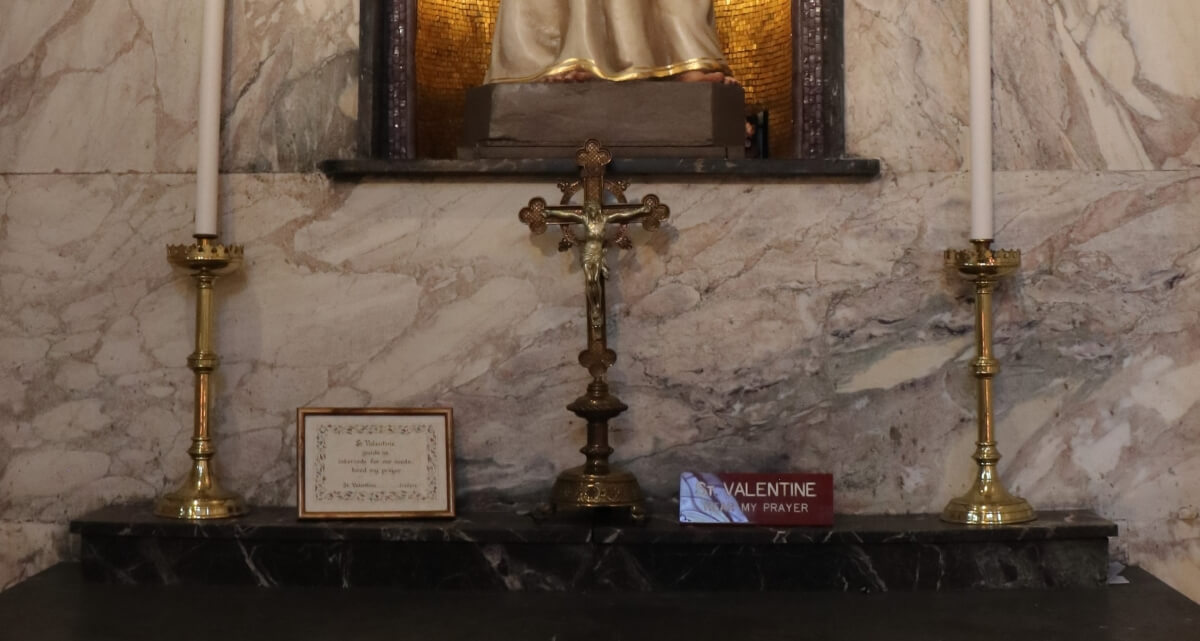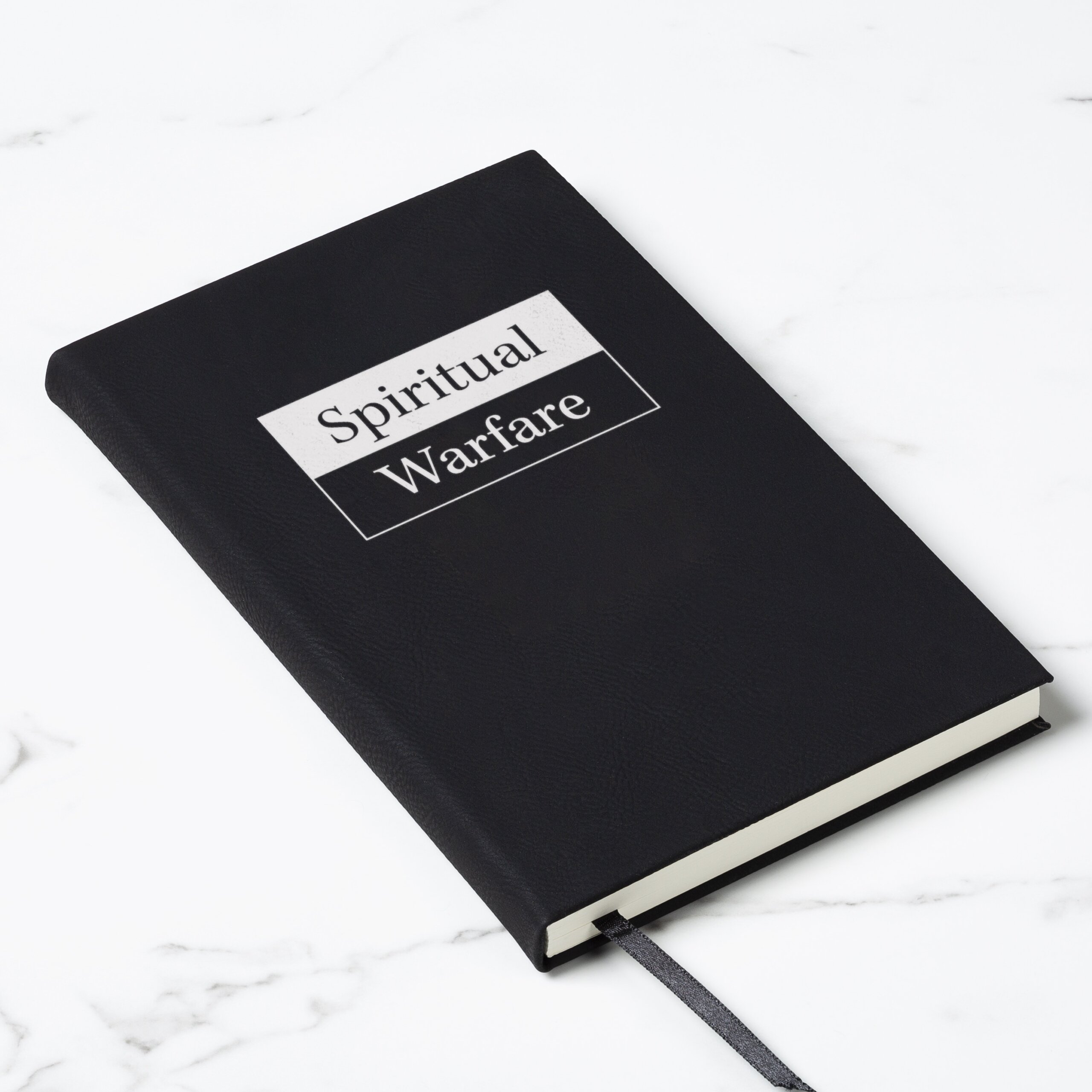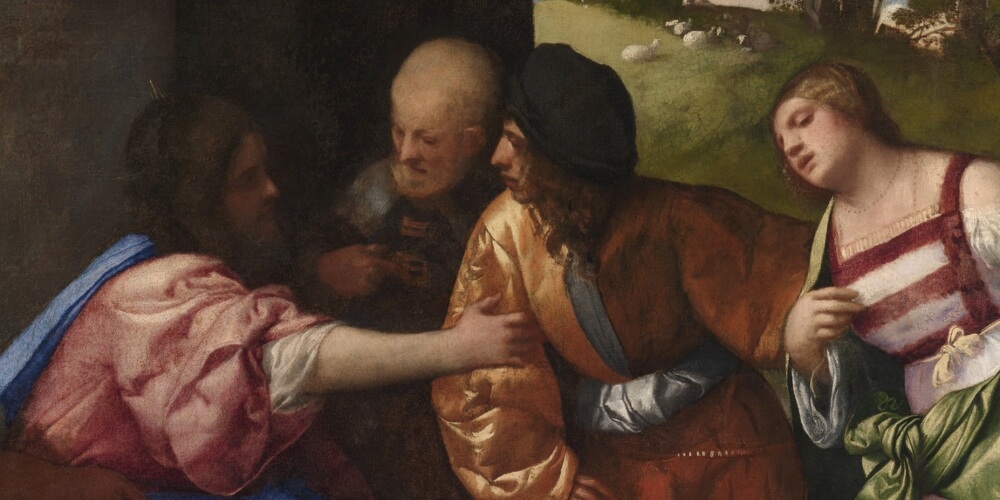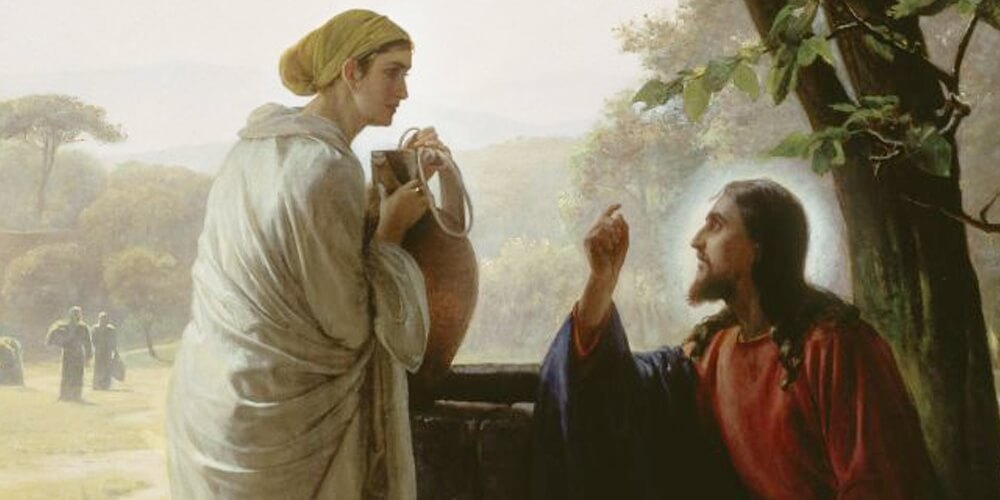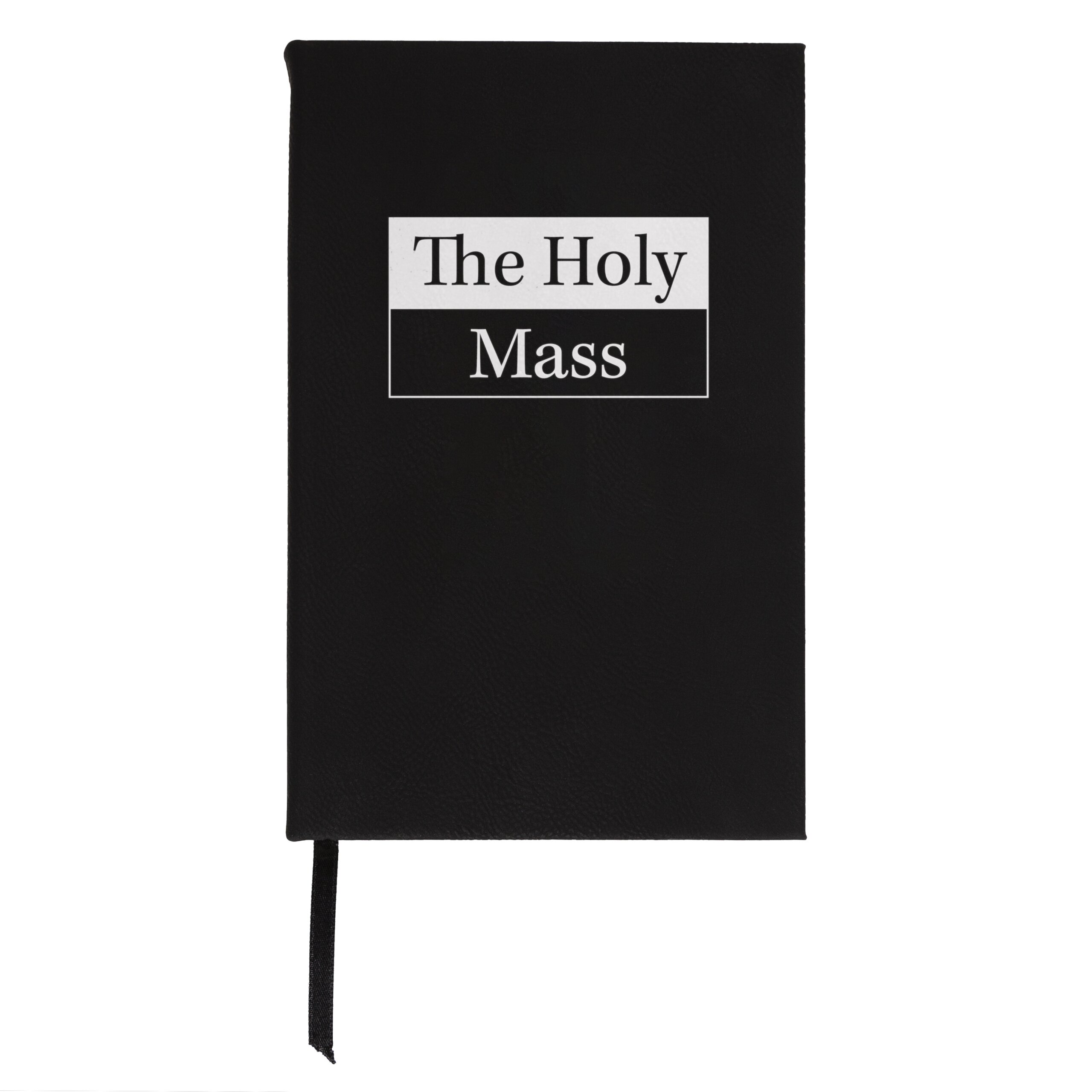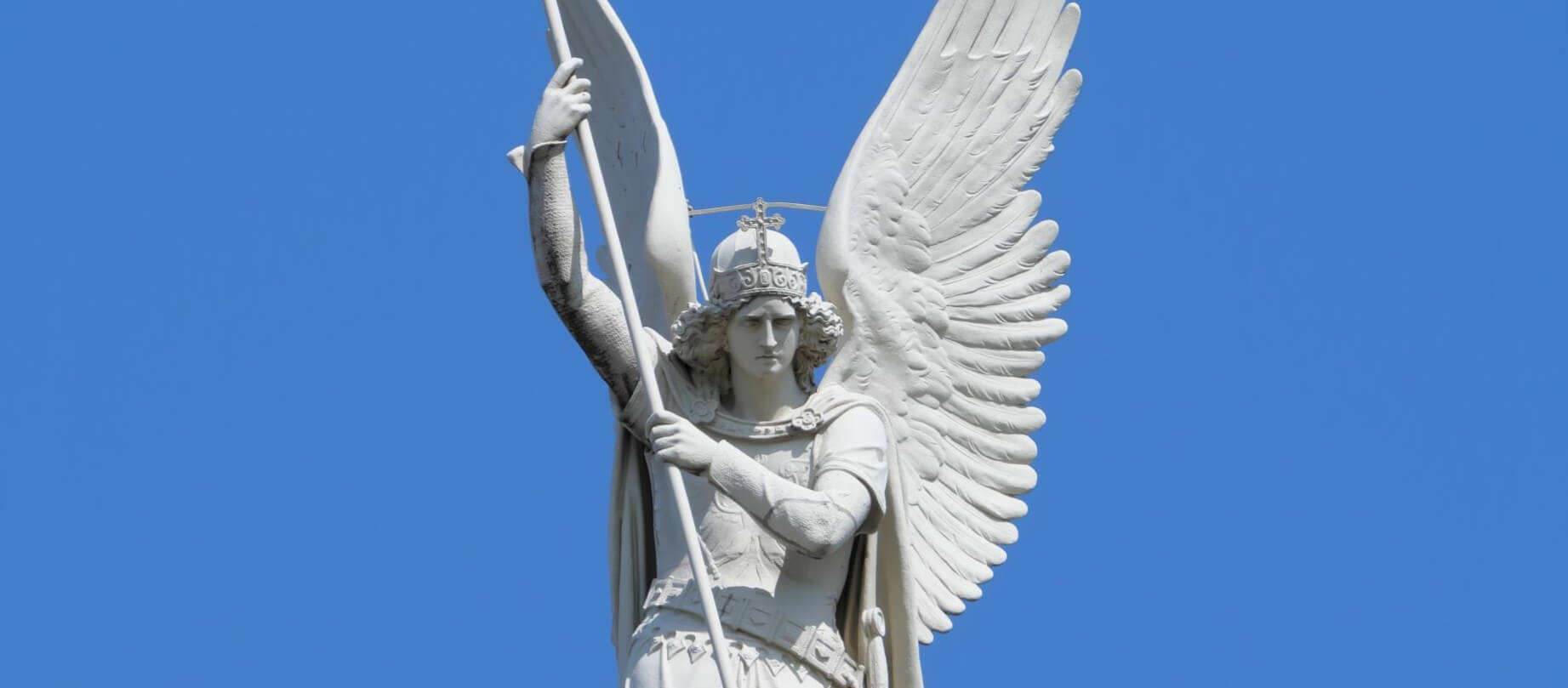
Happy Michaelmas!
In times past, the streets of the Catholic West rang with this greeting on the 29th of September. Just like Christmas—the “Mass of Christ”—so too does the term Michaelmas denote the “Mass of Michael,” that is, St. Michael the Archangel.
In the current calendar, we celebrate all three Archangels this day—Sts. Michael, Gabriel, and Raphael—and all the holy angels. But in former times, the three archangels had their own feast days, with today being the great and ancient feast of St. Michael the Archangel. Alone among the Archangels he possesses a first-class feast (for those who skip meat on Fridays, you know what that means—have a bacon burger today!).
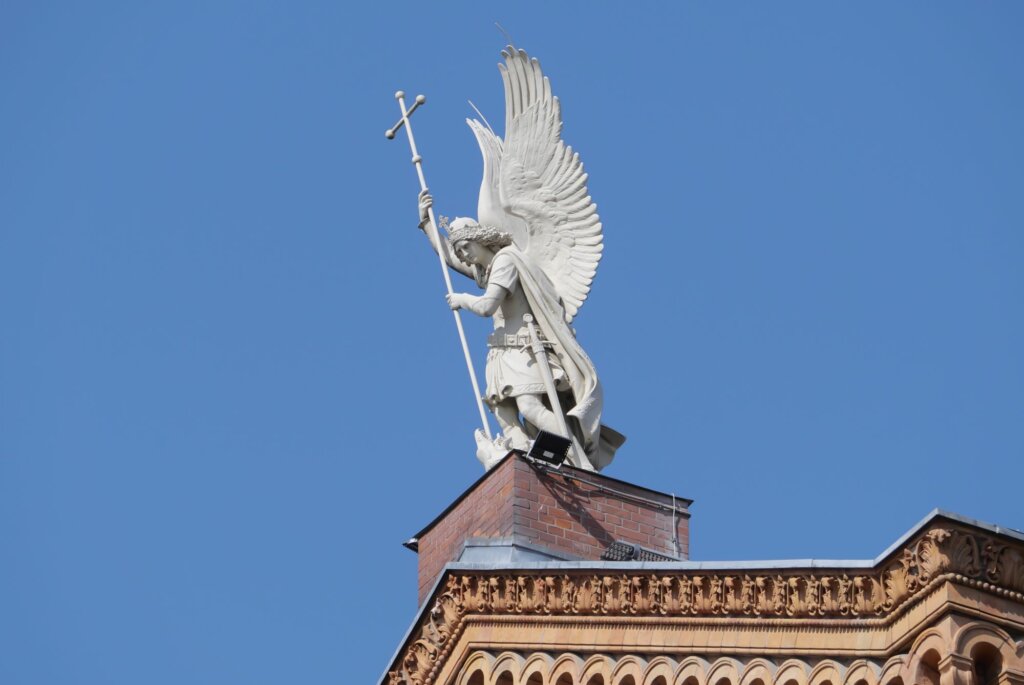
In the Middle Ages, the September feast of St. Michael was actually a Holy Day of Obligation, though this hasn’t been the case since the 1700s. Many and varied cultural celebrations existed—and still exist!—to honor this day, its importance extending even to secular affairs. In Great Britain, Michaelmas was one of the four “quarter days” of the year where debts and rents would be settled. The autumn term at many British universities is traditionally called “Michaelmas term,” as it commences on or near this feast day.
Today is, therefore, a day of immense historical significance in the Church and society at large, and reflects the high esteem in which she has always held this Archangel—and his singular role in the life and defense of God’s people throughout the ages.
Who is St. Michael?
Scripturally, we learn about St. Michael in both the Book of Daniel and the Book of Revelation (and briefly in the Letter of Jude). The Revelation passage is the most commonly known one and recounts the great war in heaven between the faithful angels and the rebellious:
Now war arose in heaven, Michael and his angels fighting against the dragon; and the dragon and his angels fought, but they were defeated and there was no longer any place for them in heaven.
Revelation 12:7-8
From here we understand St. Michael to be the leader of the good angels in their profession of fidelity to God and their defense of His kingdom.
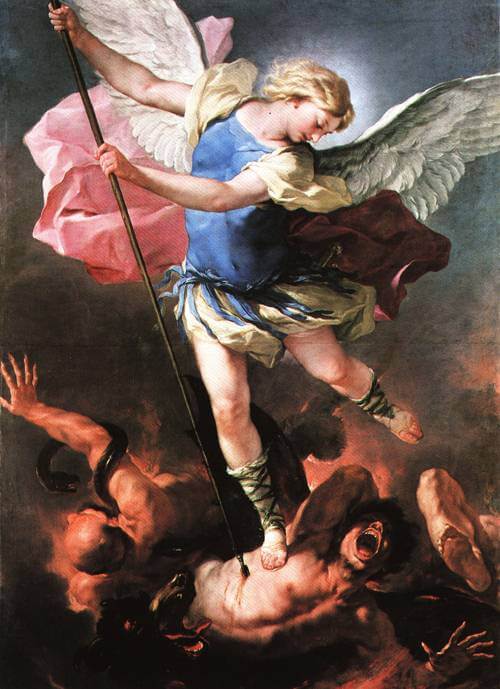
Michael’s rank of “archangel” seems self-explanatory, but if we look at what the Church Fathers and spiritual writers have to say, this could carry a number of different meanings. The archangels are the second-lowest in rank among the nine choirs, so Michael’s title could refer to his placement there. St. Thomas suggests he was the highest among the lowest rank, the angels.
However, St. Basil and other Fathers suggest that “archangel” denotes not so much a rank as his office as leader of the angels; some place him at the head of the Seraphim, the highest of the choirs.
Whatever his official ranking, he is the leader of the angels.
If we dig into the lesser-known tracts in the Book of Daniel, we see this role confirmed and expanded—he is not simply called a leader, but a prince. A heavenly being, understood to be St. Gabriel, speaks to Daniel of the trials that Israel and later the Church shall endure:
The prince of the kingdom of Persia withstood me twenty-one days; but Michael, one of the chief princes, came to help me, so I left him there with the prince of the kingdom of Persia…But I will tell you what is inscribed in the book of truth: there is none who contends by my side against these except Michael, your prince.
Daniel 10:13, 21
St. Michael is not just a prince, that is, a prince of heaven—he is our prince. The Church understands that countries and places have particular guardian angels assigned to them by God. In Michael’s case, God especially entrusted Israel, and then the Church, to his powerful protection, knowing that we would need such an intercessor in our spiritual battles against another powerful angel— Satan.
Lucifer vs. Michael
The drama of salvation is the greatest, most intriguing, gripping, hero- and villain-filled epic that ever there was. The characters are just spectacular, the stakes couldn’t be higher, and the plots, subplots, twists, turns, battles, and action scenes just couldn’t get any better. It really is the greatest story ever told. I don’t think anyone would ever consider religion or church “boring” if they really understood what was happening.
In this magnificent saga, Michael is Lucifer’s great nemesis. Once upon a before-time, Lucifer himself was the prince of heaven—his name meant “light-bearer,” and there was no creature closer to God than himself.
Of course, we all know what happened—with a deliberate “Non serviam!” Lucifer became Satan and set himself at eternal odds with God.
Fascinatingly, if St. Michael does belong to the archangel choir, Lucifer outranked him by many degrees of magnitude—and it was this lowly archangel whom God chose to lead the charge to cast out the rebellious angels from heaven.
Where pride had caused the mighty to fall, humility caused the lowly to rise. St. Michael’s name means “Who is like God?”—his astounded response, perhaps, to Satan’s proud declaration. Quis ut Deus (the Latin version of Michael’s question) is often inscribed on the archangel’s shield in classical depictions of his victory over Satan.
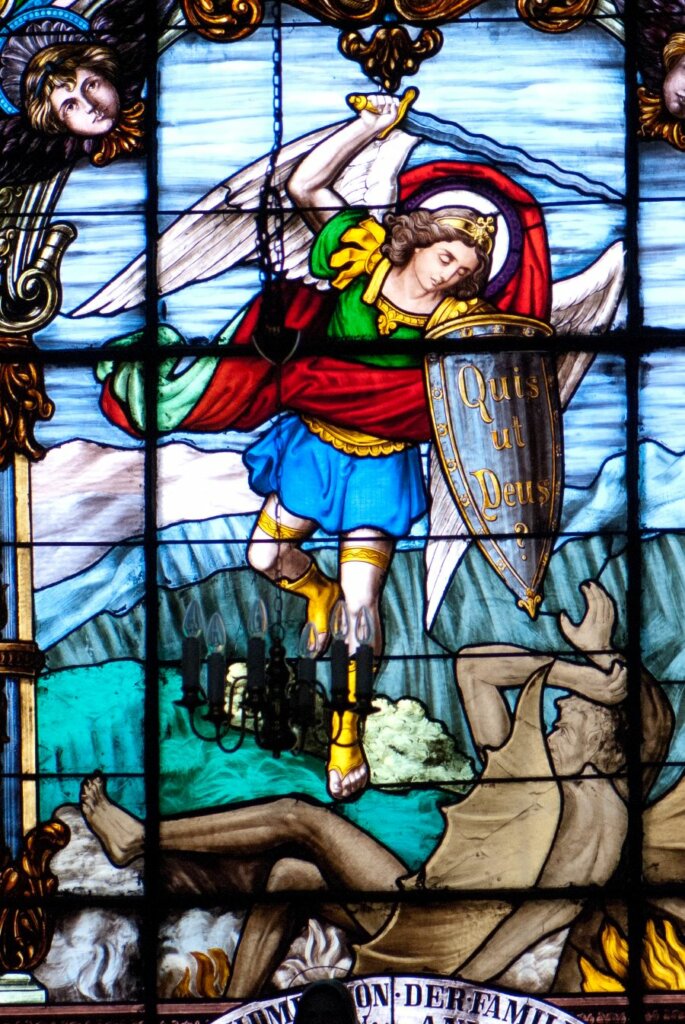
photo credit: Thomas Quine/2.0 Generic
The Apostle of Divine Mercy, St. Faustina, adds an interesting note that further assists us in appreciating the real heroism of St. Michael:
I have great reverence for Saint Michael the Archangel; he had no example to follow in doing the will of God, and yet he fulfilled God’s will faithfully.
Diary of St. Faustina, 667
He showed himself a leader from the beginning, and remains the commander of the hosts of angels and the great protector of mankind.
A Long History of Devotion
As we have seen, devotion to St. Michael goes back to the Jewish people, and the Church took up this devotion from her earliest years. Both in the East and the West churches and sanctuaries sprang up within the first few centuries, often with miraculous origin stories.
In the old calendar, today’s feast is properly called the “Feast of the Dedication of St. Michael the Archangel,” referring to a now-gone basilica that was built in Rome in the 6th century.
The oldest existing shrine to St. Michael is the famous Sanctuary of St. Michael on Monte Gargano in southern Italy on the coast of the Adriatic. Saints throughout the ages—including St. Francis of Assisi, who wouldn’t enter it because he considered himself unworthy—have visited this place, which is considered one of the holiest places on earth.
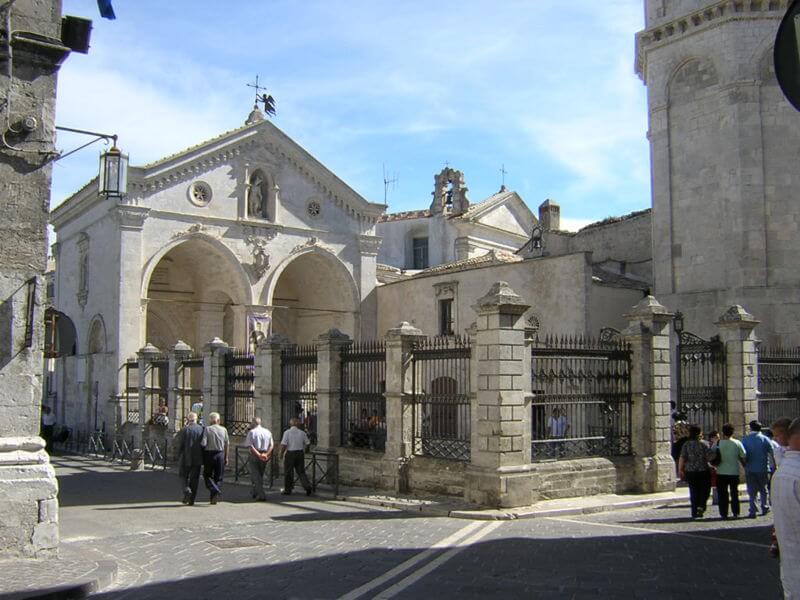
It was here in the 5th century that St. Michael appeared in the depths of a cave—his first appearance in the West (he doesn’t appear often). He asked for the cave to be consecrated, and according to legend, left his footprint in the rock!
It remains to this day the only church in the world not consecrated by human hands, but rather by the hands (and the feet) of an angel. The rocks from the cave are considered relics and have proven to be powerful against evil forces—they are used in exorcisms.
Legend tells of another appearance of the Archangel in Rome in the 6th century. During a vicious scourge of the plague, Pope St. Gregory the Great led a procession through the city to pray for relief, and saw a vision of St. Michael atop Hadrian’s Mausoleum, a giant circular building that housed the bodies of emperors from the 2nd to the 3rd centuries A.D.
The angel was sheathing his sword, signifying the end of the plague, and a bronze statue of him in this posture now graces the top of the Mausoleum—which is now known as Castel Sant’Angelo, the Castle of the Holy Angel.
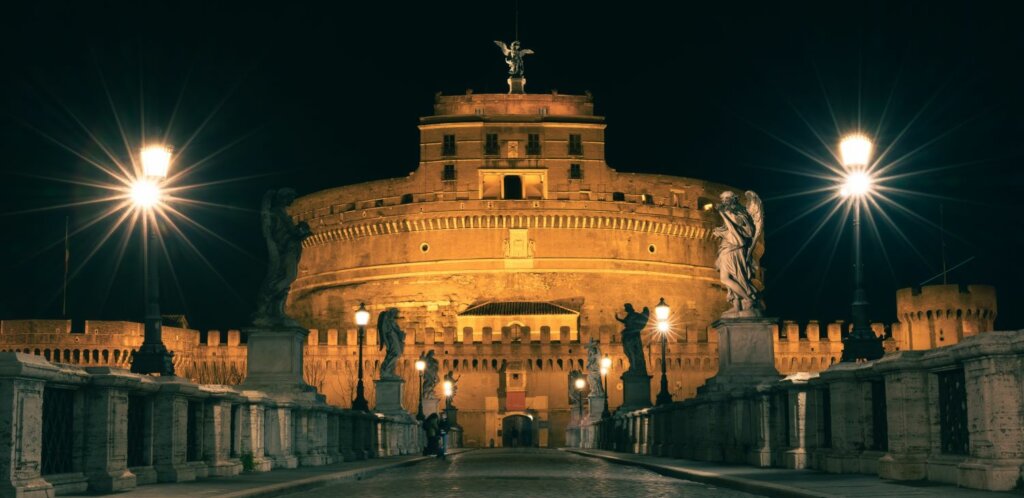
Fittingly, Michael’s castle had a career beginning in the Middle Ages as a Vatican fortress, and more than once proved the refuge of popes when Rome was threatened by attackers. Pope Nicholas III built a secret passageway to it from St. Peter’s, the famed Passetto di Borgo, which can still be walked today.
Other great sanctuaries of St. Michael—such as the iconic Mont Saint-Michele in Normandy—will need their own article in the future. For now, let’s move on to St. Michael’s place in the liturgy.
Confessing Our Sins to…St. Michael?
Confíteor Deo ominpoténti, beátæ Maríæ semper Vírgini, beáto Michaéli Archángelo, beáto Joánni Baptístæ, sanctis Apóstolis Petro et Paulo, ómnibus Sanctis, et tibi, pater, quia peccávi nimis…
I confess to Almighty God, to blessed Mary ever Virgin, to blessed Michael the Archangel, to blessed John the Baptist, to the holy Apostles Peter and Paul, to all the Saints, and to thee, Father, that I have greatly sinned…
St. Michael’s appearances in the Mass highlight again the Church’s age-old devotion to him and the importance she places on regularly invoking him.
The passage above is taken from the Confiteor found in the Extraordinary Form of the Mass—the Latin Mass. In this form, we confess our sins first to God, but also to several significant saints—first the Blessed Mother, and then St. Michael, St. John the Baptist, Sts. Peter and Paul, and finally to all the saints and the priest himself. St. Michael’s prominence among the saints and angels, and his role as the Church’s defender, make him a reasonable inclusion among the very few saints mentioned by name.
But maybe another reason is his traditional role in our judgment. Among the duties the Church acknowledges as especially belonging to Michael is the “weighing” of souls at their particular judgments. For this reason he is often portrayed with a set of scales.
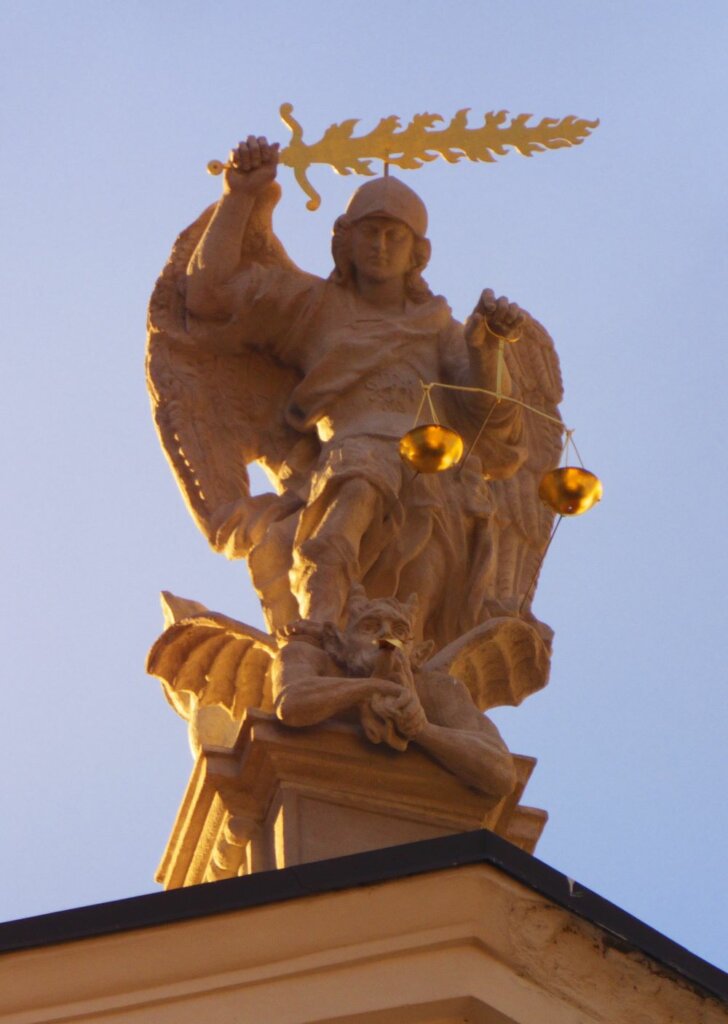
So, in confessing our sins before this angelic scale-operator, we are affirming that our sins have warranted a heavy sentence and an unfavorable reading of the scales. We are, perhaps, appealing to him for mercy—or rather, through him, to the infinite and divine Judge of all.
From my own perspective, I also think it’s incredibly humbling to confess our human weaknesses to the highest of the angels. The angelic nature is of a higher order than human nature, since angels are pure spirit and closer to God in the order of being.
Additionally, they possess none of the often-humiliating frailties endemic in fallen human nature and have never chosen sin. In a word, the angels, particularly St. Michael, are awe-inspiring in their spiritual beauty, perfection, and superhuman virtues, and placing oneself in the presence of such a being is a necessarily humbling experience.
To put it lightheartedly—if confessing our sins before a sinless non-human with a sword in his right hand and a set of scales with our souls in it in his left—if that does not stir us to repentance, I’m not sure what will!
But while humbling, this event is not intended to inspire unnecessary fear. God is ready with His mercy and St. Michael with his powerful protection. In the Mass for All Souls Day and in the Requiem Mass, in the glorious and hopeful passage of the Offertory verse, we meet the great Archangel again. He is not holding scales, he is holding the standard of God, and we pray that he might lead the departed soul into heavenly light:
O Lord Jesus Christ, King of glory, deliver the souls of all the faithful departed from the pains of hell and from the bottomless pit: deliver them from the lion’s mouth, that hell swallow them not up, that they fall not into darkness, but let the standard-bearer holy Michael lead them into that holy light: which Thou didst promise of old to Abraham and to his seed.
How to Cultivate a Devotion to St. Michael
Maybe you’re already good friends with St. Michael. But maybe you’ve never talked to him in your life! If so, now is the perfect time to break the ice. He might be the last thing a demon wants to see, but he’s a generous and constant friend to men.
A good starting point for the conversation is the Prayer to St. Michael. This short, powerful prayer is one that we should all have ready in our minds and on our tongues, especially in these times when the forces of evil are waging particularly vicious war on our Church, homes, families, cultures, and countries.
While we don’t know for sure the exact details of the origin of this prayer, it is reported that Pope Leo XIII composed it after receiving some kind of horrifying vision of Satan’s impending attacks on the Church. He ordered it, along with a number of other prayers collectively known as the Leonine Prayers, to be said after Low (that is, simple) Mass. While this is no longer a requirement, Pope John Paul II encouraged the revival of the St. Michael Prayer and many parishes now say it regularly after Mass.
Here is the text—memorize it and say it every day. Keep a holy card or framed print of it on your desk or somewhere you can see it often:
St. Michael the Archangel, defend us in battle, be our protection against the wickedness and snares of the devil. May God rebuke him, we humbly pray, and do thou, O Prince of the heavenly host, by the power of God, cast into hell Satan and all the evil spirits who prowl about the world seeking the ruin of souls. Amen.
The Chaplet of St. Michael
Did you know that St. Michael actually came himself—not so long ago, by the count of human years—to give us a special way to honor him?
In the 1750s, St. Michael appeared to a Portuguese Carmelite, Servant of God Antonia d’Astonac. St. Michael told her that those who recite the Chaplet he gave her—which honors St. Michael and all the angels—will receive an escort of nine angels, one from each choir, as they approach Holy Communion.
For those who recite the Chaplet daily, he also promised the constant help and protection of himself and all the holy angels during life, and deliverance from purgatory after death for them and their relations.
The Chaplet is easy to say and takes less than fifteen minutes. In honor of each of the nine choirs of angels, you say a particular salutation to that choir, one Our Father, and three Hail Marys. Then you say four Our Fathers in honor of the three Archangels and your guardian angel, and a closing prayer.
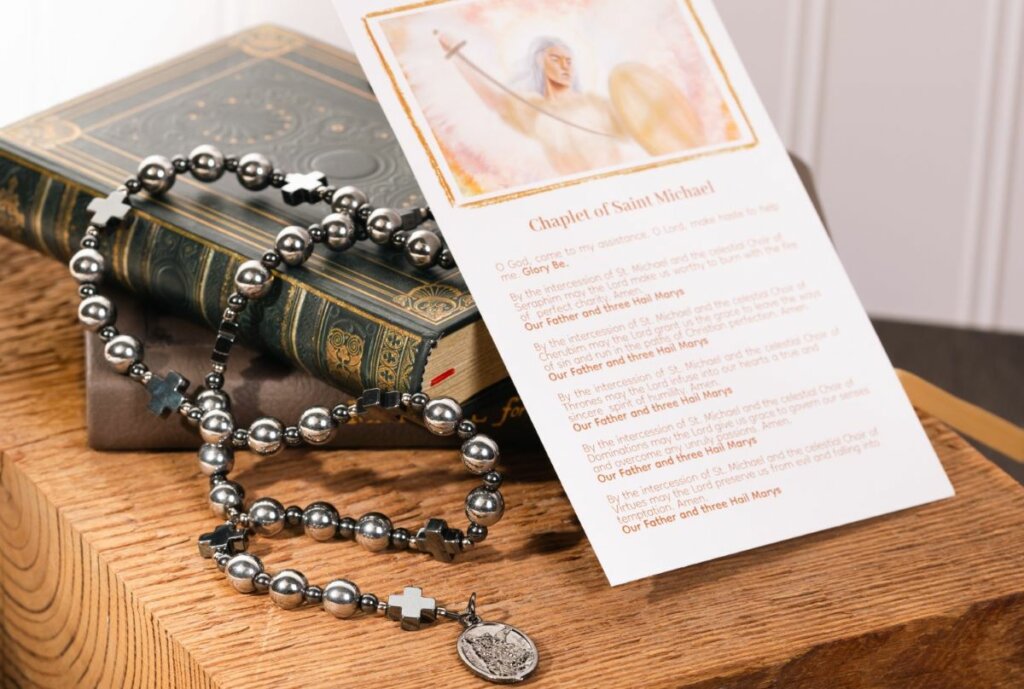
We offer several beautiful St. Michael Chaplets along with instructional prayer cards over at The Catholic Company!
Geese, Blackberries, & Daisies: Fun Ways to Celebrate the Feast of St. Michael
Popular Michaelmas traditions of the British Isles include a dinner of carrots and roasted goose—as explained by Fr. Leo Patalinghug and Dr. Michael Foley in Dining with the Saints, Michaelmas was also known as “Goose Day” since farmers brought their fattened geese to market on that day.
Another fun tradition is blackberries. Michaelmas was also humorously known as “Devil’s Spit Day,” since the devil legendarily landed in a blackberry bush (ouch!) when St. Michael tossed him out of heaven. The devil spat on the bush in anger, so beware the blackberries after St. Michael’s Day—they might be poisoned by devil-spit! You can eat them on or before Michaelmas, but not after.

Hence, blackberry pies, crumbles, and the like are suitable sweets on this day. A fine way to finish off your meal of roasted goose (Fr. Leo and Dr. Foley suggest duck as a replacement for goose if the latter is hard to obtain), along with a glass of “St. Michael’s Love,” which refers to any wine drunk this day. (Sounds like a knock-off of St. John’s Love, the wine that is blessed on St. John’s Day in Christmastide!)
And maybe decorate the table with a bouquet of Michaelmas daisies—a lovely purple bloom that flourishes between August and October!

Our Friends and Fellow-Warriors
The glorious feast of Michaelmas, however we choose to celebrate it, is the perfect time to reinvest in our friendship with the angels—our fellow-warriors, companions, and God-given guardians.
It’s more than a little awesome to think how invested they are in our salvation and how our own story is so bound up with theirs. A bad angel played the starring role in our downfall, and St. Michael and the good angels are on the front lines in the battle to get us back.
I could go on for many more pages about the angels, but I shall forbear until a near-future War on Humans article. There we’ll investigate further the angels’ relationship to the human race, their real love and reverence for humans as the race that God united to Himself in the Incarnation, and the role we play alongside them in the fight against evil.
For now, have yourself a blessed Michaelmas!
To learn more about the angels and the supernatural world and how to cultivate your relationship with them through the Chaplet of St. Michael, be sure to check out our Angelic Battle Pack.


